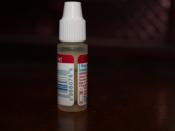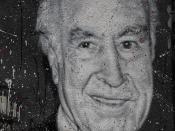LSD
Where it comes from and what it does to the body:
-----------------------------------------------------------
LSD, lysergic acid diethylamide, is a commonly abused hallucinogen drug. It is made from lysergic acid, which comes from ergot, a fungus that lives on rye and other grasses. Despite the popular theory that LSD was found by accident, it was really discovered by Louis Pasteur. He was hired by a pharmaceutical drug company, and told to research on ergot. What he found was lysergic acid, which was used to make LSD.
Sold as tablets, capsules, or in liquid form, LSD has been illegally sold on streets since 1960. Because ergot is not readily found in the United States, it is smuggled to LSD producers from Europe, Mexico, Africa, and Costa Rica. The difficulty of acquiring ergot, however, discourages many illicit manufacturers from producing LSD.
If the ergot fungus is obtained, only a small amount of it is needed to make a large amount of LSD. According to DEA publications only "25 kilograms of ergotamine tartrate can produce 100 million dosage units." Not only are the ingredients of LSD hard to find, but cooking it takes a lot of time. It takes days just to produce a few ounces of LSD. Therefore it is cooked in small batches. The crystallized LSD is converted into a gelatin squares and put in a prepared paper. Designs can then be drawn on the tablets to make them more appealing. Despite increasing production amounts of LSD, the dosage usually sold on the streets today is between 50 and 75 mg, compared to the original dosage in the 1960s.
LSD has very unpredictable health hazards. Like any drug, the greater the amount taken, the worse the effects. The user may not feel the effects of LSD from 30- 90 minutes after taking the drug. Physically, LSD dilates the pupils for a long period of time. It also raises the body temperature, heartbeat, and blood pressure. Tingling of toes and fingers is also a result of taking LSD. Even though death cannot occur from taking LSD, many LSD related deaths have been reported.
The main physical risk that LSD has on the body is the distortion of messages to the brain, especially messages related to vision. This can cause hallucinations and effects known as "hearing colors" and "seeing sounds."
Like many other drugs, the body builds a tolerance to LSD very quickly. For this reason, users must continually increase their dosage to get the desired effect. The increased dosages, as a result, harm the body to a greater extent. Common users of LSD experience weight loss and, as a result, become very thin and lose weight dramatically.
Not only does LSD have physical effects, but it also has mental effects. The effects of LSD are thought to be caused by stimulation of neurons, but it is not known. Many hallucinations cause the person to see flashes of light and intensified colors. Gradually, the images that a victim sees turn into distorted geometric designs.
When a large dosage is taken, images may appear when the eyes are closed as well as opened. Hallucinations in the mind also take place such as dream-like thoughts, out-of-body experiences, and misconception of time. Users may feel as if their mind is merged with someone else's body or an object. The moods of people who take LSD can change quickly and feelings may become mixed or disturbed. A person can be angry one moment and completely sad the next. This mood changes can occur in split seconds.
These powerful mental hallucinations can still be present when the user stops taking the drug. These hallucinations cannot be controlled and can only be cured over time.
One other dangerous effect of using LSD is a flashback. Flashbacks are recurrences of images or effects that were experienced during a previous LSD administration and they can vary in frequency and duration. They can take place on impulse and without warning, or be triggered by the use of other drugs. These flashbacks can be anywhere from minutes to hours long. Some users, however, like the flashbacks and take LSD for this "free trip" of past experiences.
LSD trips are very long. They can last as long as 12 hours. During a trip, a person experiences fear of thoughts, fear of losing control, and insanity. Even though death is not a result of taking LSD, fatal accidents have occurred with people intoxicated with LSD.
Flashbacks not only occur when the user takes the drug, but they can occur anywhere from a day later to and year later. Even though it is known that flashbacks are most common in unhealthy people, people with no health problems have also felt flashbacks years after taking LSD.
All of these effects of taking LSD are not very desirable. There is no good reason to take LSD. Taking everything into account, no one should ever use LSD.
Bibliography
The National Youth Anti-Drug Media Campaign. [On-line] available @ http://www.theantidrug.com/drug_info/drugs_lsd.html
LSD. [On-line] available @ http://www.streetdrugs.org/lsd.htm
Albert Hofmann: LSD - My Problem Child. [On-line] available @ http://www.flashback.se/archive/my_problem_child/
Health: Skills for Wellness. Crumpler, Kathy Teer; Pruitt, B. E.; Prothrow-Stith, Deborah. New Jersey: Prentice-Hall, 1997
National Institute on Drug Abuse. [On-line] available @ http://www.nida.nih.gov/Infofax/lsd.html
Leigh A. Henderson, LSD: Still With Us After All These Years, Lexington Books,1994


